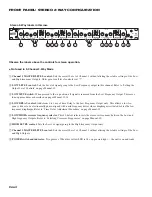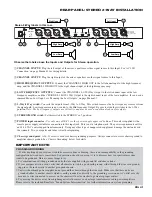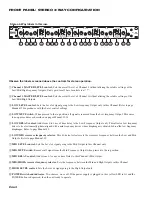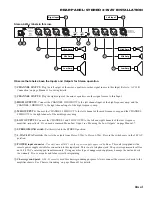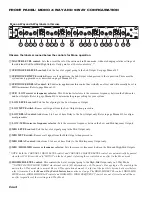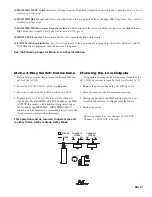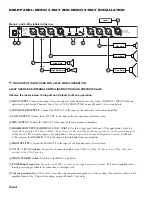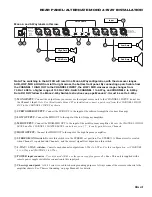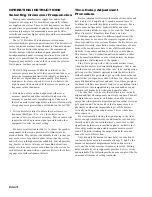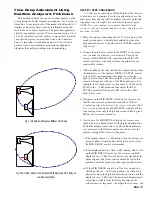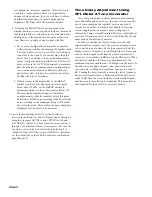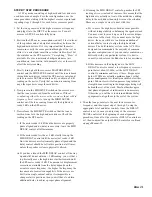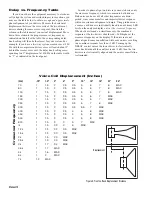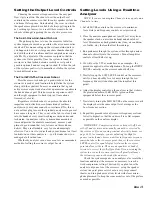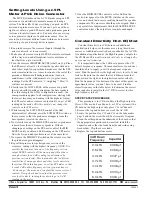
Manual-16
Constant Directivity Horn EQ Mod
Constant Directivity (or CD) horns need additional
equalization to help cover the same area a long throw horn
can cover. Additional circuitry has been added to the AC 23B
for additional equalization of the High Frequency outputs for
the CD Horns.
This modification should only be attempted by
an experienced technician.
It is important to know the 3 dB down point of the CD
driver's frequency response. The manufacturer of your driver
should be able to supply you with a frequency response
curve. Find the point where the high end
starts
to roll off, and
look for the point on the chart that is 3 dB down from
that
point (toward the right, as the higher frequencies roll off).
Find the frequency at the bottom of the chart of this point—an
approximate is fine, you don't have to be exact. Find the
closest frequency in the table below to determine the correct
value capacitor to install in the AC 23B to correct for this
high frequency roll off.
STEP BY STEP PROCEDURE
This procedure is for CD horn EQ on the High output in
Stereo 3-Way mode. For a Mono 4- or 5-Way system with a
CD horn on the high output, only place C16 in Channel 2.
1. Remove the top and bottom covers of the AC 23B.
2. Locate the positions for C15 and C16 on the Schematics
page 3 and on the circuit board. See Assembly Diagram.
3. Clean the solder pad on the underside of the board so that
the appropriate capacitor can be inserted. Install the
capacitor, and solder the leads from the underside using
fresh solder. Clip the excess leads.
4. Replace the top and bottom covers.
n
w
o
D
B
d
3
y
c
n
e
u
q
e
r
F
r
o
t
i
c
a
p
a
C
z
H
k
0
.
2
f
µ
8
6
0
0
.
z
H
k
5
.
2
f
µ
6
5
0
0
.
z
H
k
0
.
3
f
µ
7
4
0
0
.
z
H
k
7
.
3
f
µ
9
3
0
0
.
z
H
k
0
.
4
f
µ
6
3
0
0
.
z
H
k
0
.
5
f
µ
0
3
0
0
.
z
H
k
0
.
6
f
µ
4
2
0
0
.
106002
©Rane Corporation 10802 47th Ave. W., Mukilteo WA 98275-5098 USA TEL 425-355-6000 FAX 425-347-7757 WEB www.rane.com
Setting Levels Using an SPL
Meter & Pink Noise Generator
The MUTE switches on the AC 23B make using an SPL
meter an easy and relatively accurate means of tuning a
system. The Rane RA 30 has everything you need, an SPL
meter and a pink noise source. If you can’t get one of those
right now, obtain a good SPL meter and a pink noise genera-
tor from a local electronics store. You may also use a sweep
or tone generator in place of a pink noise source. If so, be
sure to look at several different tones within each crossover
section to get a good average driver response.
1. Run pink noise into the crossover Inputs (through the
mixer or directly, as is convenient).
2. Make sure all crossover output LEVEL controls are turned
all the way down and all amplifier level controls are at
least half way up to start with.
3. Turn the crossover MASTER LEVEL(s) half way up. Place
the SPL meter at least 15 feet from the speaker stack and
about chest high. Once positioned, make sure that the SPL
meter remains in the
exact
same location for the rest of the
procedure. Minimize all background noise (fans, air
conditioners, traffic, wild animals, etc.) to get accurate
readings. Set the SPL meter to “C-weighting” “Slow” if
switches are present.
4. Slowly turn the LOW LEVEL of the crossover up until
there is a healthy rumble coming from the bass speakers
(For this example the 3-Way configuration is used—the
same procedure applies to all configurations, starting with
the lowest frequency and ending with the highest). Adjust
the SPL meter and/or crossover output until you get a 0 dB
reading on the meter.
After this point do not change the
controls on the SPL meter.
5. While leaving the LOW LEVEL control at the 0dB
adjustment just obtained, press the LOW MUTE switch on
the crossover so that the pink noise disappears from the
bass speakers (revel in the silence...).
6. Now slowly turn up the MID LEVEL control so pink noise
is heard from the mid frequency speakers. Without
changing any settings on the SPL meter, adjust the MID
LEVEL until you obtain a 0 dB reading on the SPL meter.
Now the low and mid speakers are set at the same level.
7. Now press the MID MUTE switch on the crossover so that
the pink noise again disappears.
8. Repeat this process for each frequency section of the
crossover, ending with the highest frequency.
NOTE: It is
possible that you may turn one of the frequency section
output LEVEL controls all the way up and still not have
enough volume for a 0 dB reading (as determined by
previous section levels). This is probably due to different
sensitivities of amps, speakers and other level controls in
the system. When this happens, re-set the SPL meter so that
it reads 0 dB on this frequency section (you may have to
“down range” the meter and re-adjust the crossover level
control). Now go back and re-adjust the previous cross-
over level controls, turning these down to get a 0 dB
reading on the meter.
9. Once the HIGH LEVEL control is set for 0 dB on the
meter, disengage all of the MUTE switches on the cross-
over, and check that noise is emitting from all the speaker
components. The crossover should now be aligned. Make
any overall level adjustments with the MASTER LEVEL
controls and leave the output level controls unchanged.

